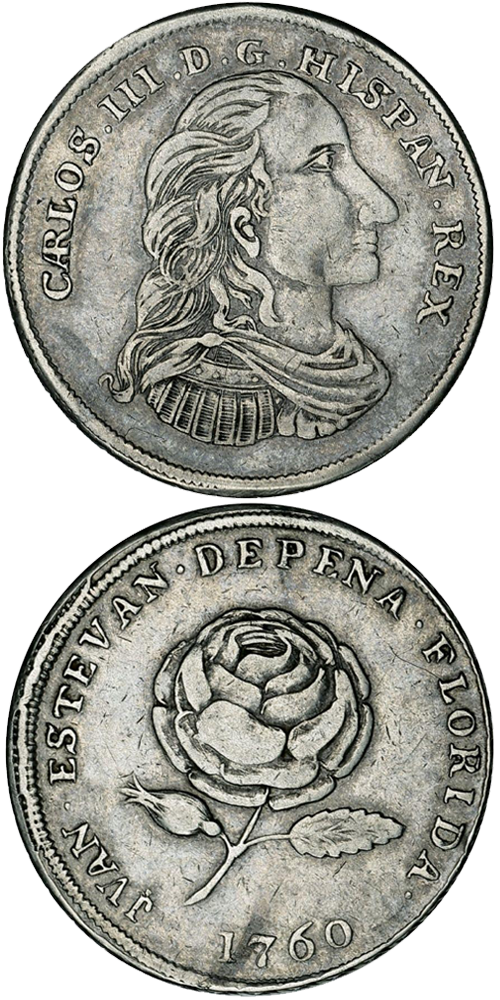Betts-454
1760 Florida Proclamation Medal of Charles III
Catalog Reference
Benjamin Betts-5
Breen-1078
Grove-K-21
Herrera, Charles III, 56
Engraver: Unknown
Composition:
Size: Diameters vary based on composition:
Weight: Weights vary based on composition:
The obverse of the medal shows an armored and draped bust of Charles III facing the right. On the reverse, a short stemmed rose is in full bloom with a bud (rose hip) on the left and a leaf on the right of the stem. There is a single Struck Silver example that has been confirmed by United States numismatist.
When a new Spanish king came to the throne it was expected that each big town and colony in Spain's New World empire would strike a coin or medal that proclaimed its citizens' loyalty to the new king. Since making dies was expensive and time consuming and since mints were few and far between, it was normal for Spanish colonial towns to make the loyalty medals as casts, like the Chinese did with their own coins at the time. Using casting molds meant that there was no danger of broken dies, local workmen could be employed to make them instead of more expensive master engravers at mints of metropolitan centers, and a nearly unlimited number of pieces could be made from a mold. In addition, local sources of silver could be used, the metal did not have to be pure or meet central mint standards, the workmanship of the casts did not have to be the finest, and local officials could control the whole affair instead of letting the business to strangers for a fee. Most of these Spanish-American proclamation pieces are casts, therefore.
Regarding Betts-454, the reverse type of a rose in full bloom was not chosen at random. During the 1745-47 period, the Mexico City Mint was ordered by King Philip V of Spain to strike a special coinage for Florida. The types for the special Florida coinage were to be a bust of the king on the obverse and a flower on the reverse (in Spanish, Florida means flower). No records survive that the special coinage was actually struck but the memory of the special types must have lingered on in Florida. When Charles III came to the throne as the new King of Spain in 1760, Juan Estevan de Peña had a silver piece struck honoring the new king. De Peña was the royal treasurer of Florida and his house still stands in St. Augustine. For the reverse type he chose the design of a flower, just as intended to be featured on the Florida coinage of 1747.
The specimen in the 1867 Mickley sale (lot 2319) was holed at the top. It served as the source for the line drawing in Herrera (1882). Breen used the Herrera drawing for his Encyclopedia listing. Herrera's illustration is different from the appearance of the (extremely rare, two or three known) cast examples and may represent a second struck specimen. If so, however, it has not reappeared since the Mickley sale in 1867! Benjamin Betts published (1898) an illustration of a cast example and noted it looked different from the Herrera piece. The cast Benjamin Betts illustration has the typical appearance seen on one other and may be taken as representative of how all of them look. The casts were not made from a mold taken from a struck specimen or its dies. Rather, the casting mold was specially prepared using the struck piece as its design model.
Joseph Mickley's piece was taken in over the counter at his bullion firm as a silver coin of the value of a U.S. half dollar. When his collection was sold his piece realized $52.50. When it was made in 1760 it was struck to the Spanish coinage weight standard and was worth 4 Reales. Our own country's coinage weight standards were based on Spain's and Spanish silver coins were legal tender in the United States until 1857. Walter Breen calls the Florida 1760 De Peña piece a ''Proclamation 4 Reales'' with good reason, therefore.
The struck example that Lyman H. Low sold in his 1898 auction of Benjamin Betts' collection (lot 758) and the one Tom Elder sold in his 1925 auction of the George Steele Skilton Collection (lot 2819) are untraced today. Likewise, the one Woodward called Very Fine in his 18th sale and the one he described as in "Perfect condition" in the Holland sale are also untraced. Given the short pedigree chain of the Ford piece it is not impossible that they are all one and the same specimen. Mr. Ford certainly thought so, as he annotated the envelope he kept this piece in with the words "The only struck specimen known to me; probably unique."
The example to the left was sold by Stack's Bowers Galleries in the January 2006 Auction, where it realized $230,000.






